Cast iron, at the heart of our know how
Jøtul has used cast iron for the manufacture of its stoves and fireplaces since 1853. It is an ideal material because it is resistant to very high temperatures and rapid changes in temperature.
Jøtul has used cast iron for the manufacture of its stoves and fireplaces since 1853. It is an ideal material because it is resistant to very high temperatures and rapid changes in temperature.
A cast iron wood stove consists of individually cast parts that are manufactured into their final shape. This process allows the cast iron to expand and contract so that it does not deform under heat.
When delivering a product that must last a generation or more, you can not compromise on the quality of materials. Just like car manufacturers with their engines, we chose the best material for the longevity of our heaters.
Cast iron can be cast in 3-dimensional molds, allowing for intricate design, from angles to ornaments. These finishes help to increase the quality level of the products - from an aesthetic as well as a functional point of view. The finished product is unified and robust, avoiding welds that are worn over time.
It is recycled from materials delivered by local scrap dealers. They are melted and rid of all impurities.
At the same time, they are given carbon and elements necessary for the alloy. When the molten cast has reached the right temperature, it is analyzed in our Fredrikstad laboratory and if needed, elements are added to guarantee Jøtul quality. The still liquid cast iron is then poured into sand molds, cooled, and finally assembled to form a brand new Jøtul stove.
Spare parts and longevity
A wood stove or cast iron insert consists of several small parts assembled together. A heat-resistant seal is applied between the various elements to ensure a complete seal of the fireplace. The ability to replace every part of the unit and the availability of Jøtul spare parts guarantees you long years of comfort and warmth.
